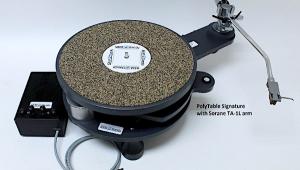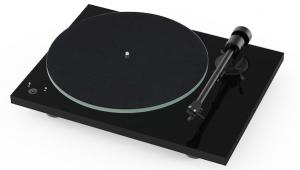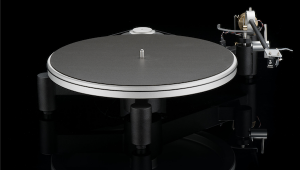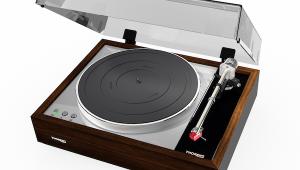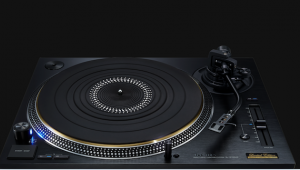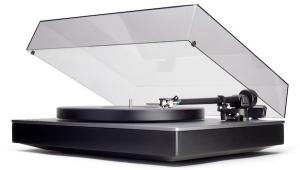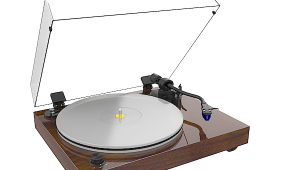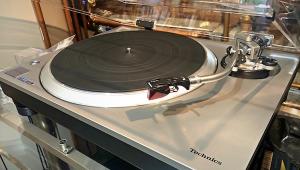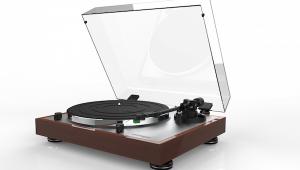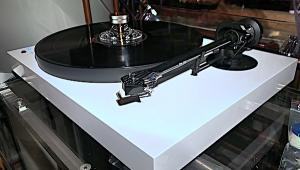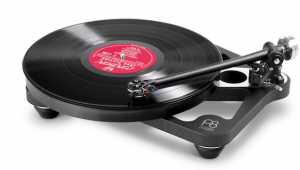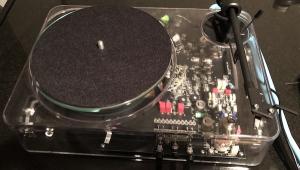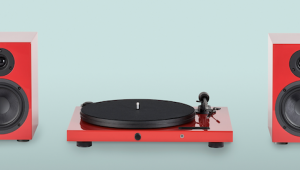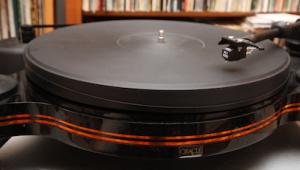Acoustic Signature Storm Mk2 Turntable Produces Clear Sonic Skies

Back in 2001 I reviewed and really liked a model called the Final Tool. It ended up being purchased by someone I knew and he’s still using it trouble-free all these years later and it still sounds solid.
We like mass loaded turntables for their solid musical grip and potentially powerful and well-controlled bass performance (“potentially” because other factors can stand in the way).
That leads to turntables that have not just great bass, but excellent “rhythm’n’pacing.
Of course minus a suspension, on what you place such a design has a significant impact both on its sonic performance and its ability to reject external vibrational sources, particularly footfalls.
The Acoustic Signature line “tops out” with the $34,000 Ascona. The $8000 Storm is third from the top, one down from the Thunder. I’m not sure if the company has a deal with The Weather Channel.
All of these ‘tables incorporate variants of a common spindle bearing design that the company guarantees for ten years.
The heart of the Acoustic Signature bearing is a thrust pad structure made of Turducken: that’s a turkey stuffed with a duck stuffed with a chicken… oh excuse me that’s the ‘60s acid kicking in. I meant to write “Tidorfolon”—a unique material made of a mixture of Vandadium, ferrite Teflon and titanium that’s claimed to be “noiseless” as well as wear-free and self-lubricating. We like self-lubricating. For turntables too.
Tidorfolon, being somewhat softer than the usual thrust pad material, allows the hardened anti-magnetic steel axle’s tungsten carbide ball tip to sink slightly into it, producing greater contact surface area as well as reduced friction and pressure.
The bearing housing, machined out of solid aluminum, is fitted with a pair of specially prepared sintered, naturally lubricated bronze bushings that have been heated to expand the material’s natural pores, which are then soaked in oil to increase the amount of retained lubricant.
Thus as the axle rotates within the shaft, the impregnated bronze bushings provide sufficient lubrication to produce a smooth spin never in need of any additional lubrication.
The problem with oil lubricated bearings, the designer avers, is that gravity causes the oil to settle below the upper contact point, which produces eventual wear. Also, the ball/pad contact point pressure pushes oil away, leaving that critical juncture without lubrication.
The bearing sits within a massive, machined, resonance -optimized aluminum plinth fitted with three beefy, approximately three-inch diameter threaded aluminum feet. The circular plinth can accommodate three bolt-on arm mounting platforms that can handle 9”-12” tone arms via an easily secured sliding mechanism.
Storm features an approximately 2” tall, 24.5 pound, full-sized aluminum platter fitted with 8 cylindrical “Silencer” brass inserts fitted with elastomer “O”-rings evenly spaced around it’s periphery.
The brass inserts serve to damp by greater than 80dB, the aluminum platter’s natural 2.2kHz peak “ring” as well as multiple higher frequency resonances. An asphalt-like material coating the platter bottom further serves to dampen residual resonances.
The graphs show the un-damped platter behavior (in red) both in time and frequency and damped with “Silencer”s (in green).
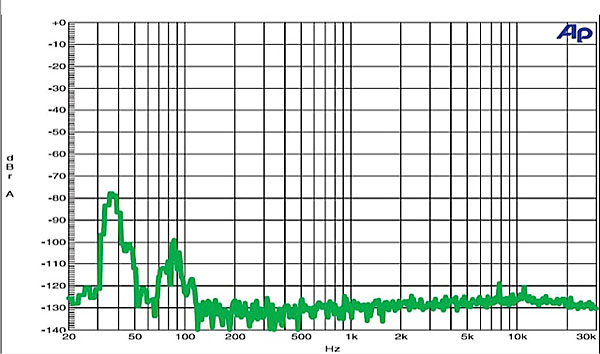
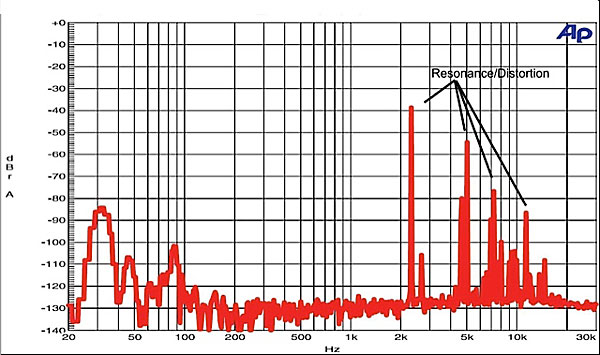
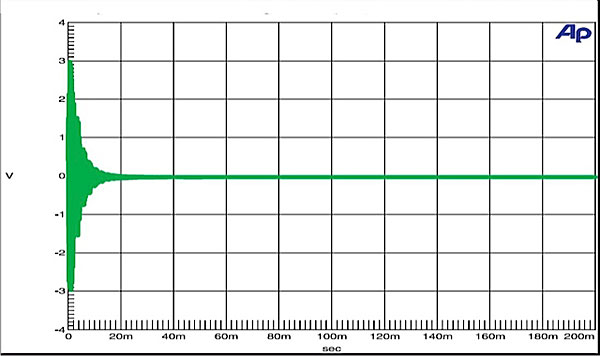
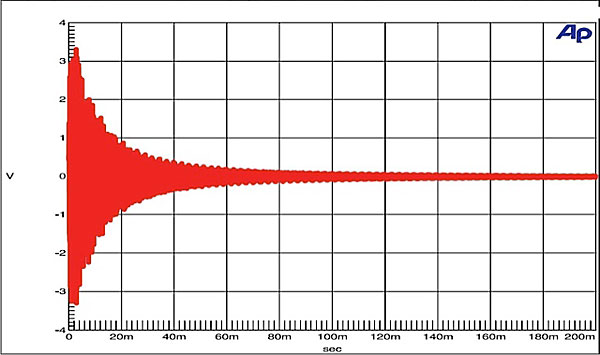
Platter drive is a via an external 12V AC synchronous motor housed in a massive pod, the pulley of which accommodates a square belt riding around the platter’s periphery.
The review sample supplied last year (this review has taken too long) has recently been upgraded to a Mark2 edition. The new version upgrades the motor controller from the Alpha-S to the new Beta Dig motor controller that’s neatly integrated within the plinth as shown in the photo. The older version featured an outboard motor controller.
The controller upgrade and integration adds $500 to the Storm’s $7500 price-tag, bringing the total to $8000.
The motor controller system converts the mains power to DC and then uses it to generate a digitally derived signal to drive an oscillator that generates a perfect 12V AC sine wave that drives the motor.
Thus the motor is impervious to mains voltage fluctuations as well as noise induced by appliances and other noise producing devices sharing the AC line.
Because the aluminum arm board platform is considerably lower than the platter top, the system requires a second aluminum platform (the one drilled for your particular tone arm) raised to the appropriate height via three cylindrical standoffs.
Set-Up
The Storm sets up easily. Because of its high mass, the trickiest part really is leveling it via the three threaded feet. You have to hold it up while turning the foot and it’s heavy! Otherwise set-up couldn’t be easier.
I was supplied a pre-drilled arm board for the Kuzma 4Point and quickly had it set up and ready to play, using a Lyra Atlasi. Yes the cartridge costs more than the ‘table as did the tonearm, but I was interested in what the Storm could do maxxed out, and not limited by the associated gear.
I began using the supplied leather mat, but it often stuck to the record and I ended up preferring the thinner of the two Boston Audio graphite mats, though because the platter is so well damped, mats have somewhat less of an effect than on some other turntables. I used the supplied record weight as well as a Stillpoints LPI.
Sound
Remember: upon what you place a mass loaded turntable like this and upon what that platform rests (concrete slab, springy wood floor, etc.) will have a major effect on its sonic performance. The Storm sat on a Finite Elemente Pagode 80 rack sitting on a concrete slab floor.
As expected from a high mass, solid design like this, the Storm begins with a rock-solid bass foundation. I use a number of “deep bass” records to judge this including Davey Spillane’s Atlantic Bridge, the title track of which features Bela Fleck and Jerry Douglas and yes, Spillane plays Uilleann Pipes so if a bagpipe isn’t your bag don’t bother. But the track traces the connection between Irish jigs and Bluegrass and it’s worth the cost of the album. Plus it’s an amazing recording. Everyone I play it for ends up looking for a copy.
The Westone bass played by Eoghan O’Neill should be very well controlled and deep on this recording but the acoustic of Lansdowne Studio should be cleanly delineated behind it. Getting this right is what well-constructed and designed high-mass ‘tables do well and for what you pay extra.
Get the foundation correct and you lock in rhythmic drive or as they call it around Stereophile, ‘rhythm’n’pacing’. The Storm does that very well. If you go from a puny ‘table to the Storm and your speakers go low you will quickly know your money was not wasted!
The Storm’s overall tonal balance was not as cool and monolithic as were its looks—not at all. In fact, the balance was on the smooth and sweet side of the tonal fence but don’t read that as mushy, because it was anything but.
The Storm does a very good job of carving out stable, three-dimensional images in space but their edge definition was not in the greatest relief I’ve heard from a turntable, nor was the blackness of the backgrounds the best, but at this price point and probably above, it ranks among the best I’ve heard.
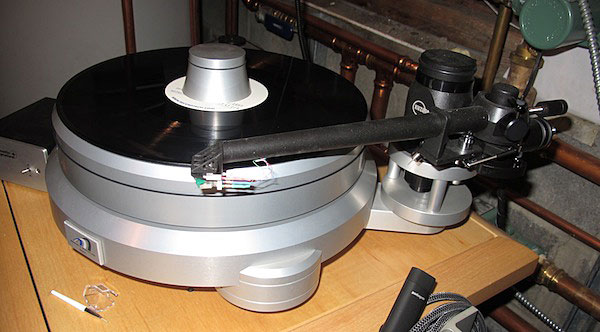
Sometimes I wished for more transient snap and sparkle but I’ll take the Storm’s drift towards creaminess over hard-edged presentations every time.
Part of the ‘table’s smooth presentation is because of the suppression of the aluminum platter’s fundamental resonance as shown in the accompanying graphs. If you’re used to a ringing platter, the Storm might sound overly warm until you get used to not hearing a platter ring.
It’s very similar to cartridge loading. If you don’t load a MC cartridge there’s going to be a high frequency resonance that adds brightness, “sparkle” and “air” that some find pleasing. Maybe so, but that resonance is not on the recording! Until your ears adjust, when you do load down and remove the resonance the sound may seem overly warm and even rolled-off even though it really isn’t (unless you over-load beyond critical damping).
If you listen to a great deal of vocal music, male or female, you’ll really like the Storm’s presentation. There’s plenty of vocal weight and solidity minus overhang. Johnny Hartmann’s voice was particularly well-served as were all baritones. Well-recorded female vocals were full but not too thick and they certainly weren’t over-sibilant or thin sounding.
String tone was, as you might expect, equally smooth and warm, with greater emphasis on the woody resonance than on the bow scrap. Same with piano: more sounding board, less hammer on strings.
The supplied mat produced a more pronounced sense of smoothness, as did the Merrill-Scallia cork/lead mat, which is why I preferred the slightly more lively graphite mat. This ‘table is sufficiently resolving to deliver the full effect of these tweaks.
If you listen primarily to rock’n’roll you’ll love the weight and structure of the bottom end but you might wish for more speed and sparkle on top. But if your cartridge of choice is on the mellow side to begin with, you can always (and easily) find a brighter, faster cartridge.
Speed stability and accuracy were very good within ±2% measured using the Dr. Feickert Platter Speed iPhone app (remember: this is a review of the original, not Mk2 version with the improved motor controller).
The original outboard motor controller has internal pots that allow you to adjust speed. Luckily I knew about these, because for some ridiculous reason they are not mentioned in the instruction manual. The ‘table arrived running more than a few percent fast but was easily adjusted.
At one point during the review period I kept thinking this ‘table probably compares favorably to the VPI Classic 3 but the Classic 3 costs about $1000 less and includes an arm.
However, without one here to directly compare, what’s the point of speculating? Then came a call from a friend whose friend had a Classic 3 in need of a set-up. Over they came and though the cartridges were different and I didn’t do the comparison in the presence of my friends, I did listen to the Classic 3 (which I’d reviewed in Stereophile) and then soon afterwards, the Storm.
The Classic 3 with its un-damped aluminum platter is somewhat livelier, faster and more forward, even with a mat in place. It’s bass performance roughly comparable. And though the motor is onboard, the backgrounds were subjectively equally black—and both produce really black backgrounds.
The price advantage goes to the VPI because it is American-made and passes through fewer hands on its way to your door plus it includes a very good tone arm. But the flexibility advantage goes to the Storm because you can easily change tone arms and add two additional ones—something you can’t do with the VPI. Also, if you wish to take advantage of VPI’s digital motor controller you’ll have to add a $1200 SDS.
That said, both of these 'tables and many others too help make the circa $8000 price point crowded and interesting. Don't jump in before doing your research. On the other hand you really cannot go wrong with the Storm.
Conclusion
Time spent with the Acoustic Signature Storm was anything but “stormy”. Instead with every play I kept referring to it as “old faithful”—not that I ever took its performance for granted!
It worked flawlessly throughout the review period and never failed to deliver rock solid musical performance. Your choice of tone arm will affect the final sound, but one of the moderately priced Rega arms will get you started well and produce much of the bottom end weight, slam and control the Strom delivered with ease mated with Kuzma’s 4Point.
Storm is the “sweet spot” in the Acoustic Signatures upper end line, which makes it the line’s most attractive in terms of price/performance ratio. $8000 is also a competitive price point so be sure to check out offerings from other manufacturers.
The ones with spring or other types of suspensions will be easier to place and more resistant to outside vibrations but few if any will produce the Storm’s bottom end authority and slam. A good example of a suspended competitor is the $7000 Avid Volvere.
Another contender at this price point that I’ve reviewed is the direct drive Brinkmann Bardo. It might not have the Storm’s bottom end slam and overall smoothness but it’s highly resolving in the midrange and airy on top without sounding bright. I’ve heard it benefits from placement in a massive (and expensive) custom plinth. The Storm essentially comes with one.
I’ve not reviewed the $8900 Kuzma Stabi Reference but it’s another attractive choice at this price point but add a digital motor controller like the one that comes standard in the Storm and you’re up to around $9800.
Most audiophiles willing to spend $8000 on a turntable are thinking “this will be my final turntable” and they are probably correct. It is a hell of a lot of money to spend on a record spinner.
If you do commit to spending that much money, you should at least know you’re buying a well-made product from a company that’s been around a while and can provide back-up in case of problems.
Acoustic Signature has been around for a long time and has a very good reputation for reliability and service should it be necessary.
Therefore, The Acoustic Signature Storm is not the only recommended turntable at the $8000 price point (price includes a pre-drilled arm board for your choice of tone arm), but it’s a great and flexible one that’s easy to recommend!
If $8000 is beyond your means, Acoustic Signature will soon introduce the WOW! It features the same bearing design and motor, and features a 9 pound platter. Price will be $1950 with a Rega 202 tonearm.


